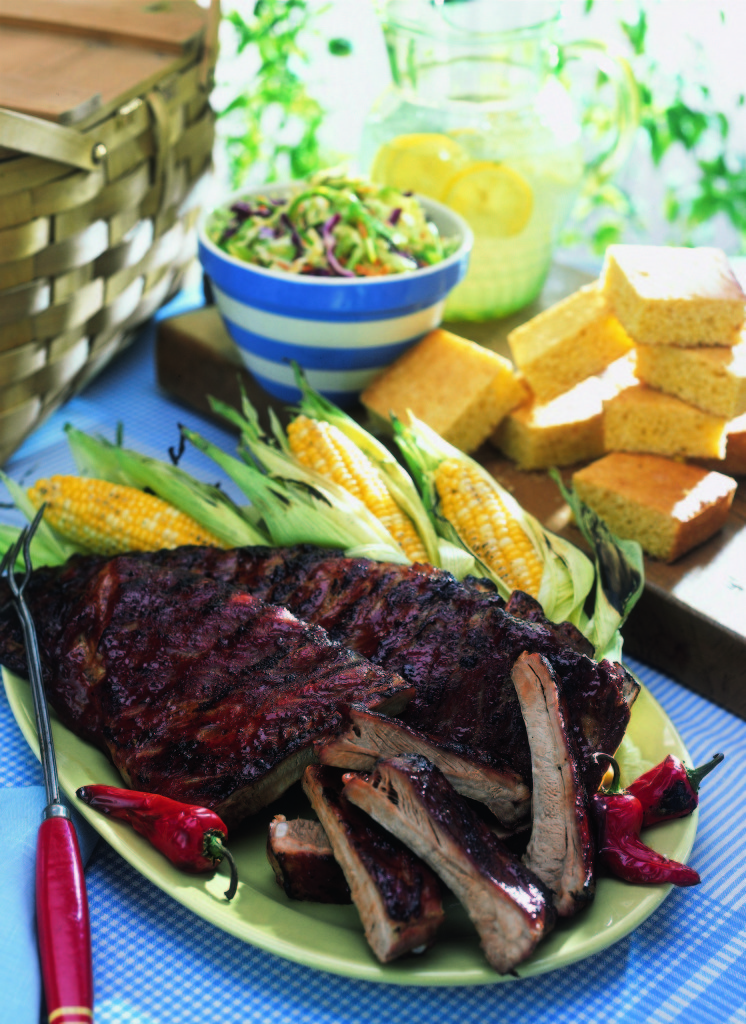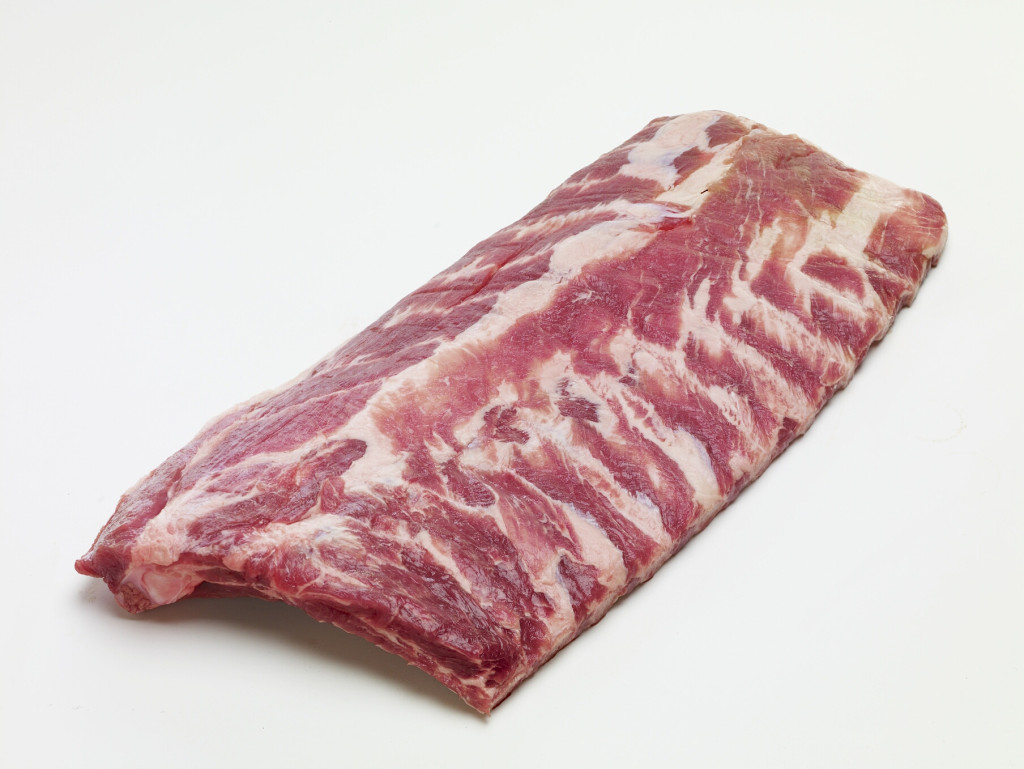The Lobel family of Lobel’s Prime Meats in Manhattan and Lobel’s of New York online butcher shop are fourth- and fifth-generation butchers. With our Cut of the Month series, we will bring you their wealth of knowledge and expertise on specific cuts of meat, including their unique characteristics, preparation methods, and how to select the best cut.
Unlike Memphis, Kansas City, Texas, and the Carolinas, St. Louis, MO, is not often mentioned in the same breath when listing the capitals of American Southern-style barbecue. But it does lend its name to one of the primary types of pork ribs.

Why St. Louis gets short shrift in barbecue name recognition isn’t clear. St. Louis has a long tradition of distinctions that include some unique regional specialties.
Pork steak, for example, is a St. Louis phenomenon not found widely outside the lower Midwest. Pork steaks are bone-in slices of Boston butt, of the pig’s shoulder, which are seared on the grill and then simmered in a tomato-and-vinegar-based sauce.
Crispy snoots are pieces of pig snout and cheek that are smoked and/or grilled until crunchy, something akin to fried pork rind or chicharrón, and served as a sandwich or an appetizer.
St. Louis-Style Barbecue
By strict definition, barbecue is a style of cooking that is laid-back, low-and-slow, usually in the 225–250°F temperature range, and takes art and patience to render sumptuously smoky, tender delights from cantankerously tough cuts of meat. Grilling, on the other hand, is a more heat-aggressive style of cooking done at temperatures of 350°F or higher.
In truth, St. Louis barbecue is a bit of a misnomer because most is not done low-and-slow; rather grilling is the predominant method.
Another outstanding feature is St. Louis-style barbecue sauce, sort of a mash-up of Carolina and Kansas City styles of sauce. From the Carolinas, St. Louis sauce gets its relatively thin consistency, vinegar base, and mustard accents. From Kansas City, it gets its sweetness and tomato base.
St. Louis Ribs
So what makes a pork rib a St. Louis-style rib?
First, let’s take a look at ribs in general.
A hog’s rib bone runs from the sternum/belly to the spine.
- Closest to the sternum are short lengths of cartilage called rib tips.
- Moving toward the backbone, the next and longest section is the spare rib.
- Connected to the backbone, baby back ribs are easily identifiable by their characteristic curved bone.

St. Louis ribs are a subsection of the spare rib in which the sternum, cartilage, and ribs tips have been removed. This type of butchering is preferred by many cooks because the result is a rectangular rack of 12–13 ribs that is even in size and shape from end to end. As a result, they are easier to barbecue, grill, or smoke for consistent and predictable results, unlike baby back ribs that are curved and shorter at one end and long and flat at the other.
St. Louis ribs are also preferred by many because of their meatiness as well as their marbling/fat content which renders during the cooking process to keep the ribs moist.
Like all rib sections, St. Louis ribs have a membrane on the underside. There is a long-standing debate about whether or not to remove that membrane before cooking. The no-membrane faction argues that the membrane is a barrier to the absorption of seasonings and smoke into the meat. The pro-membrane side of things claims that the membrane helps hold the rib together and doesn’t really affect flavor that much because the membrane is mostly covering bone.
If you want to remove the membrane, place the ribs meat-side down on a counter or cutting surface. Slide the tip of a sharp knife under one corner of the membrane and work the knife a bit to separate the membrane from the bone to create a “tab” of membrane that you simply pull away from the rib bones. Grabbing the tab with a paper towel will give you a sure grip when pulling.
Buying the Best St. Louis Ribs
Some hallmarks of a great quality St. Louis ribs are even, meaty coverage on the top side of the rack. Evenly distributed marbling will produce juicy ribs that baste themselves throughout the cooing process. However, avoid large areas of fat covering the meat.
As always, fresh is best. The color may vary with commodity pork being a light tan color to incredible Berkshire or heritage pork which will be a deep rosy pink.
Check the vacuum-sealed packaging for any seam breaks, tears, or any discoloration (greenish-bluish) or dry spots on the meat. Also, it is not uncommon for vacuum-sealed pork to have a slight odor when broken free of the confinement of the vacuum sealing. This is to be expected. The odor will dissipate in a few minutes once exposed to the air or rinsed with cold water. If the odor does not go away and is accompanied by discoloration, the ribs should not be consumed.
Cooking St. Louis Ribs
After far as cooking technique, the same procedures can be used for cooking St. Louis ribs as for baby-back ribs, except St. Louis needs a little more time.
For dry ribs, add a dry rub liberally on both sides of the rib rack and allow to rest for a couple of hours or overnight. Bring to room temperature before cooking.
If you want wet ribs, apply any sauce or glaze within the last half hour of cooking, especially if what you are adding has any sugar or other sweetener. Applying it at the right time will allow the glaze or sauce to caramelize to crispy, delicious perfection. Apply it too early and the sugars will burn and turn bitter.
Checking for Doneness
While an internal temperature of between 180–190°F is the preferred doneness range, getting an accurate reading on a rack of ribs is not easy. The rule of thumb is to check the temperature away from the bone, which conducts heat readily. The problem is that there really isn’t anywhere on a rack of ribs that is not right on top of the bone.

Therefore, the checkpoints for doneness with ribs are when the meat shrinks back from the bone and the tip of the rib protrudes about a ¼ to ½ inch. The second indicator is when you lift a rack of ribs turning the underside up. The rack should relax and crack a bit without falling off completely.
Recipes and Videos
Click this link for a handful of rib recipes. Even though they specify baby back ribs, St. Louis ribs can be easily substituted with some additional timing.
Or watch as our friend Troy of T-Roy Cooks demonstrates his technique with St. Louis ribs.
Do you prefer St. Louis or baby back ribs? Are you a dry ribs or a wet ribs sort of person? Do you prefer to oven-roast, grill, barbecue, or smoke your ribs? What’s your favorite sauce, glaze, or dry rub.



Leave Your Response